Spider-view: "Vibranium Vendetta"
Three 1991 annuals tell a somewhat standard if not entertaining team-up between Spidey, Iron Man, and Black Panther, cementing a stronger story than the lackluster back-up strips
—by Nathan on February 21, 2023—
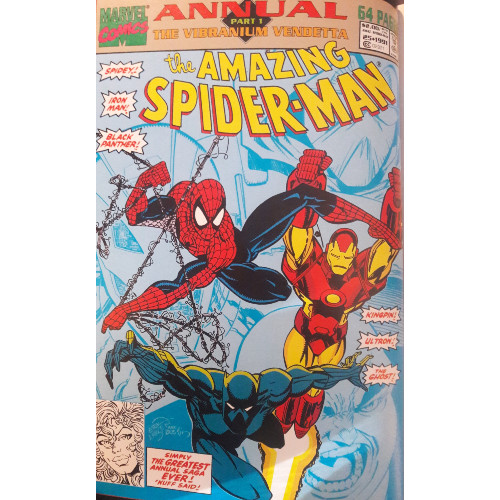
To quote Sam Eagle in A Muppets Christmas Carol, business is “the American way!” “You will love…business,” he dramatically tells a young Ebeneezer Scrooge, to which the soon-to-be apprentice agrees. As the years pass, Scrooge discovers he does love business, particularly the way it lines his pockets.
Capitalists of all kinds pop up in the pages of funny books, generally in the form of super-criminals, arch-fiends, or dastardly moguls. Remember Lex Luthor? We hate that guy. Norman Osborn? Him, too. Wilson Fisk? The scallywag. These one-percenters possess power and flaunt it in the faces of their famed foes, secure in believing their indefatigable fortunes will spare them the embarrassment of defeat or the humiliation of prison.
Even heroic industrialists find themselves waking up on the wrong side of the moral bed and, every so often, scoot on over to the “above reproach” side of philosophy. Good old Tony Stark has had more than one dangerous brush with alcoholism and once went rogue to take down a bunch of stolen tech, even going toe-to-toe with the U.S. government. Batman, for all the philanthropic endeavors alter ego Bruce Wayne pursues, once devised a method of dropping the Justice League in case they ever turned to the dark side. Absolute power and all that, as the saying goes…
David Michelinie is no stranger to uncovering nefarious plots conducted by captains of industry. Justin Hammer often pops up on his radar (see: “Demon in a Bottle,” “Stark Wars,” and Cardiac’s first appearance), but for this series of annuals, corporation Roxxon is the target for a trio of superhuman allies. Spidey teams up with the Golden Avenger and the King of Wakanda to confront a business that, once again, puts its financial concerns ahead of consideration for the public’s welfare…and we all know what can happen when responsibility takes a backseat to power.
“The Vibranium Vendetta”
Writers: David Michelinie, Terry Kavanagh (back-up strip script), Gerry Conway (back-up strip plot), Fred Hembeck (back-up strip script), Tony Isabella (back-up strip script), Peter Sanderson (back-up strip script)
Pencilers: Guang Yap, Sal Buscema, Alan Kupperbeg, Paris Cullins, Steve Ditko, Marie Severin, Ron Wilson, Fred Hembeck, Don Hudson
Inkers: Jeff Albrecht, Sal Buscema, Alan Kupperberg, Bud LaRosa, Steve Ditko, Fred Hembeck, Keith Aiken, Dave Cooper, Don Hudson
Colorists: Bob Sharen, Evan Skolnick, Ed Lazellari, Kevin Tinsley, Marie Javins, Reese Witterstaetter
Letterers: Rick Parker, Chris Eliopoulos, Fred Hembeck, Ken Lopez, Brad K Joyce
Issues: Amazing Spider-Man Annual #25, Spectacular Spider-Man Annual #11, Web of Spider-Man Annual #7
Publication Date: September 1991
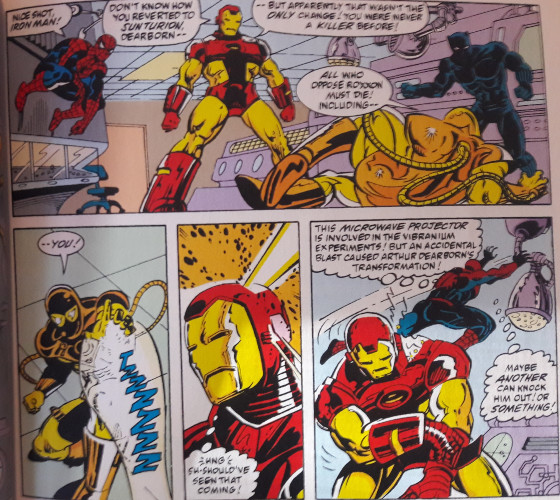
Cross-superhero stories, I’ve occasionally found, stretch the limits of believability in order to make a premise work. “Coincidence” is used as often as the writer’s pen to shape a story–Ant Man happens to be at the same science conference Peter Parker attends, or Iron Man struts into the same science conference, uh, Peter Parker attends, or…okay, Peter attends a lot of science conferences, alright?
Point being: you generally don’t have to be a brilliant egghead to get a couple of costumed do-gooders together (nor, generally, do you gotta be a genius to get them to dust up due to an ill-conceived misconception, but I digress). If you wanna bring these guys into the same story, you just gotta whip something up, quickly. Tales such as these are tenuous, at best.
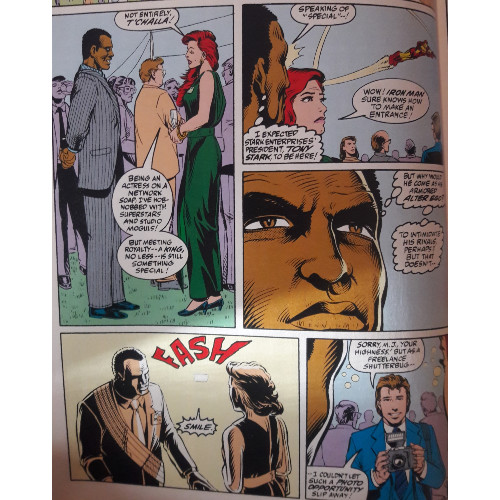
For these annuals, Roxxon is the glue which holds our Friendly Neighborhood Spider-Man, Armored Industrialist Iron Man, and Mighty Monarch Black Panther together. Kudos, actually, should be extended David Michelinie for creating a plot that doesn’t seem forced or cockamamie. It’s Roxxon’s forays into developing artificial vibranium which pulls in our baddie-busting buddies, a situation which is laid out very neatly by Michelinie and developed well over the three annuals. Peter Parker attends a grad program at Empire State University, which hosts a Roxxon showcase; Tony Stark shows interest as a competitor; and Prince T’Challa worries how the possible creation of stable artificial vibranium will impact his nation’s economy. Natural events cause our friends’ paths to collide, allowing the story to develop naturally.
There’s a surprising amount of complexity to the narrative as Michelinie strings in a handful of supervillains to, assumedly, entice audiences, strategically selecting villains with histories and vendettas (get it?) against our heroes. Ultron, the aforementioned Kingpin, and Ghost all find themselves, tenuously, working together, balancing out our heroes fairly well (Kingpin is a longtime Spidey foe when he isn’t beating on Daredevil, the Ghost is an industrial espionage agent with a history of sneaking into corporations named “Stark,” and Ultron seeks the precious element produced in Wakanda). Like our heroes, we’re given three fairly different villains whose inclusion could seem haphazard–Ultron does, admittedly, feel the most random of the bunch, but he’s introduced via a continuation of a West Coast Avengers narrative, and his M.O. aligns with the story’s functions fairly well, so I’ll allow it to slide.
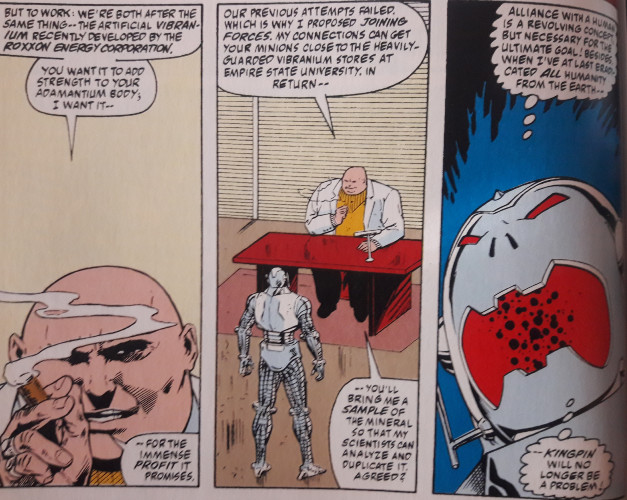
Like some of his other narratives, Michelinie seems intent on showcasing how corporate power and greed can be detrimental to society, particularly in how he depicts flaws in the artificial vibranium Roxxon is processing. Thus, amidst the superhero shenanigans and pretentious plotting, a somewhat-subtle environmental message is woven through the piece. A subplot-ish element established early on carries greater importance during the climax, evidencing Michelinie’s foresight in developing the entire story. There’s a subtlety here akin to the crescendo-ing moments of “Demon in a Bottle”–you may not be able to figure out the final picture early on, but you can pick up on some of the pieces or even point a finger and go, “That story beat, right there, will probably be important later on.” But given you may not be certain about the specifics, props should be given Michelinie for teasing the reader without whomp-ing them over the head with a metaphorical baseball bat.
This contrasts quite nicely, actually, with the whole “U.S. government converting the gold standard to cocaine” plot Michelinie ran for a Spidey/Punisher team-up in a few regular ASM issues. That tale was predicated on a monumentally off-the-walls twist that failed to reach the depth it strained for. The whole plot was enveloped around this ridiculous notion and proved too far-fetched to make sense. Here, Michelinie’s narrative is constructed more upon character, much like how “Demon in a Bottle” stressed Stark’s battle against alcohol addiction.

To do so, Michelinie ropes in Arthur Dearborn, a somewhat-reformed villain once known as Sunturion…and I say “somewhat” because he’s still Sunturion and also because he works for the corrupt, conniving capitalists at Roxxon. Of all the characters, he’s allowed the most depth. Spidey, Iron Man, and Black Panther don’t necessarily grow throughout the arc; their direction is set from the start: this knockoff vibranium is dangerous, bad Roxxon, stop. Same for the villains: want, steal, destroy, kill. Dearborn, however, is allowed struggle. He’s a company man, toes the line…mostly. Michelinie places Dearborn in a unique position where he simultaneously acknowledges the abuses Roxxon commits but feels he’s in no position to blow the whistle on these malicious muckety-mucks. He is the character upon which the conflict is constructed, a human face staring out into the more philosophical notions Michelinie preaches.
The whole story ebbs and flows fairly well. Action sequences feel standard yet entertaining–pencilers Guang Yap and Marie Severin are especially adept at illustrating a lithe yet powerful Black Panther. And the occasional fun moment surfaces: Mary Jane mingles with T’Challa at the Roxxon exposition, Ultron drives a spidery tank, and Iron Man drills down several miles into the earth in what is touted as “perhaps the most Herculean effort of [his] career,” which makes for a great moment but probably doesn’t hold up factually thirty years later.
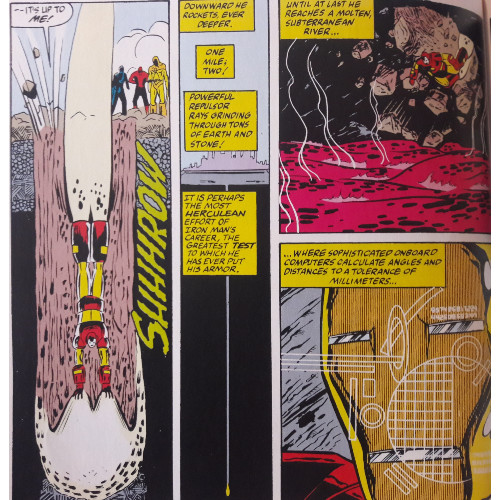
And in case this trilogy of tantalizing tales wasn’t enough to whet your whistles, we’ve got several back-up strips, similar to the format of 1990’s Spidey annuals. I’ll discuss those for a minute.
The draw of the 1990’s strips was the sheer creative firepower behind them. You had guys like Tom DeFalco, J.M. DeMatteis, Gerry Conway, Gil Kane, Spidey-co-father Steve Ditko, Peter David, Mike Zeck, Rich Buckler, Todd McFarlane, and Ross Andru contributing their talents to a variety of short stories of shifting quality. Several of the stories were fairly amusing, including a 12 Angry Men-style courtroom drama by David and June Brigman starring MJ, a surprisingly interesting two-part Sandman story focusing on his continued reformation, and a short tale where Aunt May helped the Punisher stop some bad guys by faking a heart attack.
Yes, I just wrote the last portion of that sentence.
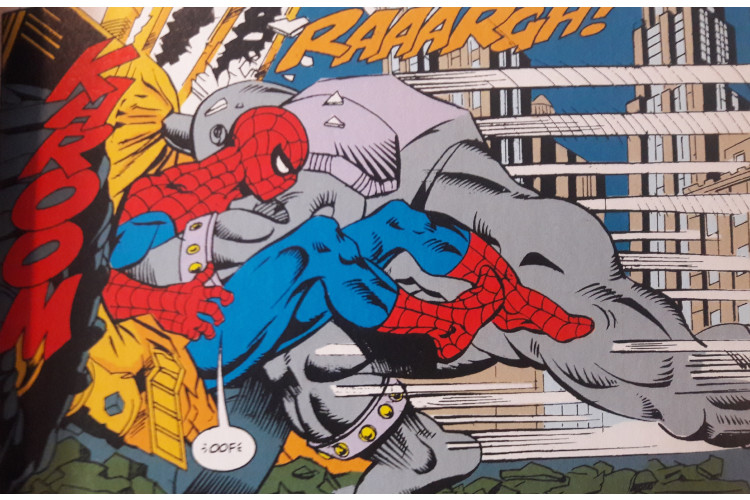
So you had several talented folks contributing to several stories, and sure, some were middling, but on the whole, they proved to be more entertaining than the main event. I was hoping for something a little similar here…and though some of these tales are okay, none prove to be as enticing as last year’s model.
Part of me believes this chalks up to the talent included: yeah, you’ve still got some starpower here–Ditko, Conway, Sal Buscema, Fred Hembeck–but not as much as on 1990’s roster, nor are these individuals used as well. Several of the included strips feel like extended recaps: Buscema is woefully underused on a retelling of Peter’s origin, as are the contributors on recaps of Venom, the Hobgoblin, and the Green Goblin’s histories. The idea of the recaps is kinda nice for those perhaps unfamiliar with the characters, and I’ll admit that, given this blog’s historical perspective, seeing writers mention arcs like Venom’s first appearance and island duel with Spidey, Ned Leed’s death, Jason Macendale’s deal with N’astrith, or Spidey and Ghost Rider’s showdown with the Demogoblin are nice reminders of stories I’ve covered previously. But it seems like a bit of a waste when you consider that another short story or two could have better used the page space.
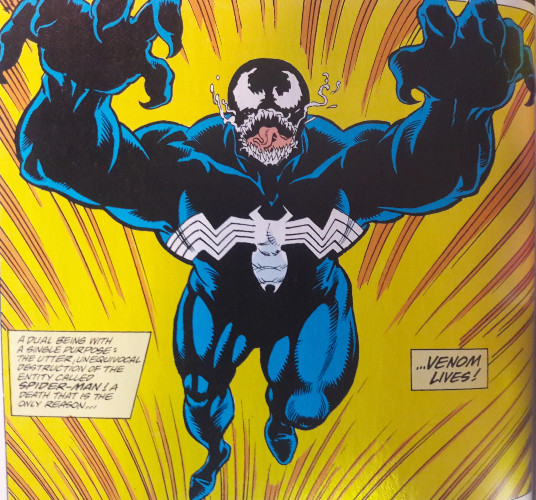
Some of the content also feels oddly slotted, as if contributors were looking to fill the pages instead of using the annuals to present entertaining one-and-done stories. We get a weird fight between Spidey and a strangely monosyllabic Rhino, set prior to his Deadly Foes of Spider-Man appearance, published earlier that year. A Rocket Racer/Speed Demon scuffle continues a previous narrative started in Marvel Tales, giving us the second half of a story. And Venom pops up for his own narrative, which takes place between ASM #315 and ASM #316. Given that both the Rhino and Venom were temporarily off the table at this point–the Rhino had his "skin" removed, and Venom chose seclusion on his island paradise–I suppose it’s logical to set tales before their last known appearances. But it is a tad jolting.
Not even sterling Steve Ditko can rescue a flat tale starring Chance, though seeing Spidey’s co-creator return, even briefly, is a treat. Perhaps the one decent narrative included is a three-part story starring Silver Sable and her Outlaws (Rocket Racer, Prowler, and Will-O-the-Wisp) as they square off against the Sandman. This seems to be a continuation of Sandy’s own reformation arc, as seen in the 1990s annuals and during his brief stint with the Avengers. It’s an action-packed romp with one somewhat interesting twist. I will note that Fred Hembeck does deliver an interesting comic strip-esque piece focusing on a younger Peter Parker learning a bit of responsibility, actually stringing in a fairly impactful running gag as Peter tries to babysit a kid who just won’t sit still.
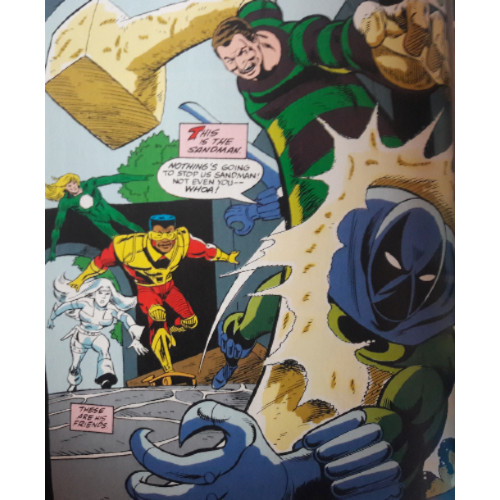
For these annuals, somewhat surprisingly, we have the opposite of the 1990s annuals: a main story which outweighs the back-up strips. “Vibranium Vendetta” is certainly a more believable story than Spidey getting shrunk to the size of an ant and definitely feels more densely plotted and thought through. We get some great Black Panther and Iron Man appearances, plus some fun villain work between Kingpin, Ghost, and Ultron. The back-up stories tend to be a tad disappointing, primarily as none of them stand out as overly impactful or entertaining, and relegate an unfortunate number of pages to recapping origin stories. I suppose, then, that will just have to be my vendetta to deal with, if only in ink and not vibranium.